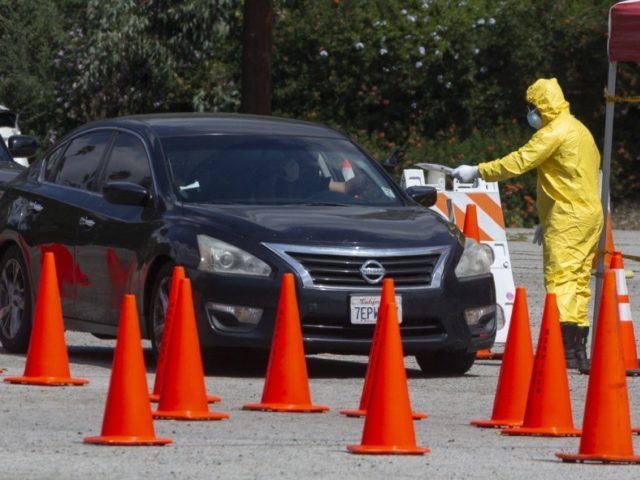The Institute of Health Metrics and Evaluation (IHME) updated its coronavirus model on Wednesday and pushed back its recommended “safe” reopening dates for several states into the second half of June and pushed the “safe” date for North Dakota back to July 19.
It was the second update to the model in two days.
According to the update from the IHME that accompanied Wednesday’s release, the recommended “safe” date to begin reopening Florida was pushed back to June 14, almost two weeks later than the “safe” date of June 1 announced in the April 17 update.
Similarly, the “safe” date to begin reopening Arizona was pushed back to June 26, two weeks and four days later than the “safe” date of June 9 announced in the April 17 update. The recommended “safe” date to begin reopening Kansas was pushed back to June 21, almost three weeks later than the “safe” date of June 1 announced in the April 17 update.
In Georgia, where Gov. Brian Kemp announced on Monday he would be authorizing a number of “non-essential” businesses such as hair salons and fitness studios to open on Friday, the IHME model pushed the “safe” date to begin opening the state back up to June 22, three days later than the June 19 date set in the Tuesday, April 21 update, and a week later than the June 15 date set in the April 17 update.
Remarkably, in North Dakota, one of a handful of states where the governor has not issued a mandatory stay at home order, the IHME has pushed back the “safe” date to begin opening the state back up to July 19, three weeks later than the June 29 date announced in the April 17 update. North Dakota has implemented only two of the six social distancing policies included in the IHME model: educational facilities were closed on March 26 and initial business closures, the date when “[t]he first phase of non-essential businesses [were] ordered to cease on-premise operations,” were announced on March 20.
North Dakota, one of the most rural states in the country, has seen a relatively low number of coronavirus cases and deaths. As of Thursday, the North Dakota Department of Health reported the state had just 709 cases of coronavirus and 15 deaths, with 18 coronavirus patients currently hospitalized.
In its April 17 update, the IHME explained that it determined the “safe” date to begin reopening a state was “based on when the upper bound of the 95% uncertainty interval for all-age COVID-19 prevalent infections falls below 1 per 1,000,000.” The model defines the “safe” date as the date when “relaxing social distancing may be possible with containment strategies that include testing, contact tracing, isolation, and limiting gathering size.”
Overall, the number of projected coronavirus deaths increased from 65,976 in the Tuesday, April 21 update to 67,641 in Wednesday’s update.
Georgia Gov. Brian Kemp, a Republican, has announced the most aggressive reopening plans in the country, with non-essential businesses such as hair salons and fitness studios given the green light to reopen this Friday.
Kemp’s reopening plan has come under criticism from Democrats and Republicans alike. President Trump even singled out Kemp’s plan in Thursday’s White House Coronavirus Task Force briefing on Thursday as reopening “too soon.”
Kemp, however, remains undaunted:
Kemp said more Georgia businesses will be allow to reopen on Monday, subject to “specific social distancing and sanitation mandates.” They include theaters, private social clubs and restaurant dine-in services.
Atlanta Mayor Keisha Lance Bottoms disagrees with the governor’s decision.
“When I look at the data, I see our [COVID-19] numbers are going up,” Bottoms told CNN. “I have searched my head and my heart on this and I am at a loss as to what the governor is basing this decision on.”
State health officials, however, reported a sharp drop in new coronavirus cases this week. Thirty new cases were logged Thursday, down from a peak of more than 700 nine days ago.
The IHME explained why the “safe dates” for five states–Washington, Florida, North Dakota, Arizona and Kansas–were pushed back further in the update released on Wednesday:
The exact reasons why the dates have shifted are unique to each state, but some shared characteristics are present. First, all five states now have higher cumulative COVID-19 death projections since the April 17 release. The updated death model, which now uses COVID-19 cases as a leading indicator to predict epidemic peak and overall shape, has resulted in longer peaks and tails for many states. Except for North Dakota, these states appear to have already experienced peaks in daily COVID-19 deaths, but the duration and shapes of their downward trajectories are changing as updated data can be incorporated into the models.
For instance, in Washington state, an uptick in daily COVID-19 deaths captured in time series between the April 17 release (input data through April 16) and yesterday’s release (input data through April 20) increased the state’s total COVID-19 deaths to date by 30. Subsequently, Washington’s descent from its epidemic peak is now slower than previously estimated – and thus the projected timing of potentially easing distancing measures is being pushed back further as well.
Importantly, the four other states had initial date predictions in June, a time period that is inherently less certain than estimates for May – especially when updated data inputs occur in terms of location-days. As emphasized in our April 17 release, these projections could change as new data become available and/or different policies are implemented. This is particularly true for states with comparatively fewer COVID-19 deaths (for example, North Dakota, Kansas, Arizona).
As Breitbart News reported, updated versions of the IHME model released since April 17 are “designed to influence the dates governors choose to reopen their states.”

COMMENTS
Please let us know if you're having issues with commenting.